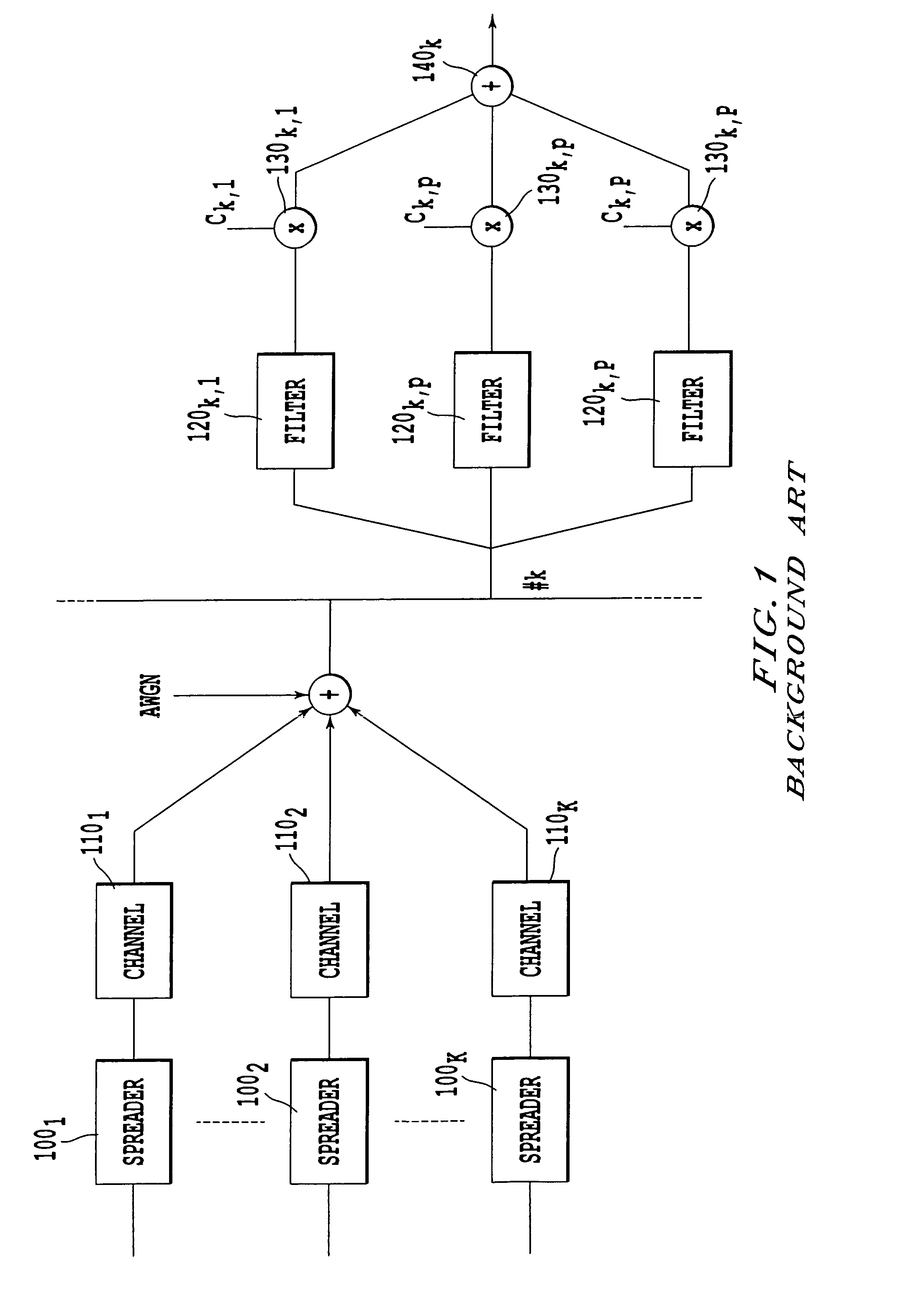Multi-user detection method
- Summary
- Abstract
- Description
- Claims
- Application Information
AI Technical Summary
Benefits of technology
Problems solved by technology
Method used
Image
Examples
second embodiment
[0085] it is considered that the phase difference remainders are negligible and therefore that the coefficients ci,k are essentially real.
[0086]There is then chosen:
ui,k=|ci,k| or ui,k=ci,k or ui,k=Re[ci,k] (10)
[0087]where Re[.] represents the real part.
[0088]In the same way, the coefficients bl,i,k are considered to be pure phase differences. The terms wl,i,k can then be chosen so as to reconstruct the phase differences corresponding to the coefficients bl,i,k applied in (420k).
[0089]According to a first variant embodiment, there is then chosen:
[0090]According to a second variant of the invention, a linear regression is effected on the values ψl,i,k as described in French application FR-A-0011160 filed on 29 Aug. 2000 in the name of the applicant and incorporated here by reference. More precisely, for a given path i, the values {circumflex over (ν)}i,k and {circumflex over (φ)}i,k which minimise the mean square deviation J are sought:
[0091]J(v^i,k,φ^i,k)=∑l=1L(v^i,k+(l-1)·φ^i,k-...
fourth embodiment
[0123]FIG. 8a depicts a multi-user detection device according to the invention.
[0124]This embodiment extends the parallel elimination mode in the sense that it now includes a “multi-equalisation” function which will be explained below. The reference numbers indicated are the translations of those of FIG. 6 when they correspond to identical fictions. The device depicted in FIG. 8a nevertheless differs from the one in FIG. 6 in that it comprises a linear filter (805) upstream of the decision modules (810k). The purpose of this filtering is to take into account the outputs of the receivers of the first type or second type (800k) at different sampling times in the elimination of the interference. The filter (805) is a transverse linear time filter which fulfils a role equivalent to that of a conventional transverse linear equaliser when a single user is considered. Unlike the latter, however, the filter (805) is a matrix filter which operates on size vectors K and therefore uses matrice...
fifth embodiment
[0126]FIG. 9 depicts a multi-user detection device according to the invention.
[0127]This embodiment transposes the technique of equalisation by decision feedback (DF) in the multi-user context. The modules (900), (910), . . . (980) are modules identical to the modules (800), (810), . . . , (880) of FIG. 8, each module operating, as stated, on a vector with K components. The device comprises a precursor transverse filter (905) identical to the filter (805) and a postcursor filter (907) filtering the vector of the symbols ŝ′k at the output of the module (950). The output of the postcursor filter is subtracted (906) at the input of the decision module (910). The assembly consisting of the transverse filter (905) and the feedback filter (907) can, there too, be optimised according to a known technique, ZF or MMSE for example.
[0128]The postcursor filter (907) must be causal so as to ensure that there is no need to subtract the contribution of time samples not yet available at the time of...
PUM
 Login to View More
Login to View More Abstract
Description
Claims
Application Information
 Login to View More
Login to View More - R&D
- Intellectual Property
- Life Sciences
- Materials
- Tech Scout
- Unparalleled Data Quality
- Higher Quality Content
- 60% Fewer Hallucinations
Browse by: Latest US Patents, China's latest patents, Technical Efficacy Thesaurus, Application Domain, Technology Topic, Popular Technical Reports.
© 2025 PatSnap. All rights reserved.Legal|Privacy policy|Modern Slavery Act Transparency Statement|Sitemap|About US| Contact US: help@patsnap.com



